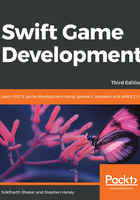
Tracking the player's progress
First, we need to keep track of how far the player has flown. We will use this later as well, for keeping track of a high score. This is easy to implement. Follow these steps to track how far the player has flown:
- In the
GameScene.swiftfile, add two new properties to theGameSceneclass:let initialPlayerPosition = CGPoint(x: 150, y: 250) var playerProgress = CGFloat()
- In the
didMovefunction, update the line that positions the player to use the newinitialPlayerPositionconstant instead of the old hardcoded value:// Add the player to the scene: player.position = initialPlayerPosition
- In the
didSimulatePhysicsfunction, update the newplayerProgressproperty with the player's new distance:// Keep track of how far the player has flown playerProgress = player.position.x - initialPlayerPosition.x
Perfect! We now have access to the player's progress at all times in the GameScene class. We can use the distance traveled to reposition the ground at the correct time.
Looping the ground as player the moves forward
There are many possible methods to create an endless ground loop. We will implement a straightforward solution that jumps the ground forward after the player has travelled over roughly one third of its width. This method guarantees that the ground always covers the screen, given that our player starts in the middle third.
We will create the jump logic on the Ground class. Follow these steps to implement endless ground:
- Open the
Ground.swiftfile and add two new properties to theGroundclass:var jumpWidth = CGFloat() // Note the instantiation value of 1 here: var jumpCount = CGFloat(1) - In the
createChildrenfunction, we find the total width from one third of the children tiles and make it ourjumpWidth. We will need to jump the ground forward every time the player travels this distance. You only need to add one line at the very bottom of thecreateChildrenfunction:// Save the width of one-third of the children nodes jumpWidth = tileSize.width * floor(tileCount / 3)
- Add a new function named
checkForRepositionto theGroundclass, after thecreateChildrenfunction. The scene will call this function before every frame to check whether we should jump the ground forward:func checkForReposition(playerProgress: CGFloat) { // The ground needs to jump forward // every time the player has moved this distance: let groundJumpPosition = jumpWidth * jumpCount if playerProgress>= groundJumpPosition { // The player has moved past the jump position! // Move the ground forward: self.position.x += jumpWidth // Add one to the jump count: jumpCount += 1 } } - Open
GameScene.swiftand add this line at the bottom of thedidSimulatePhysicsfunction to call theGroundclass's new logic:// Check to see if the ground should jump forward: ground.checkForReposition(playerProgress: playerProgress)
Run the project. The ground will seem to stretch on forever as Pierre flies forward. This looping ground is a big step toward the final game world. It may seem like a lot of work for a simple effect, but the looping ground is important, and our method will perform well on any screen size. Great work!
Note
Checkpoint 4-B
The code up to this point is available in this chapter's code resources.